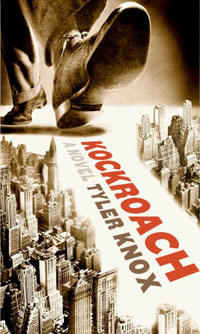|
| ||
| A bug's life
by Joe Foster Kockroach by Tyler Knox. William Morrow 2006. 368 pages. One of the most prevalent literary conventions nowadays is the recycling of classics, meaning that seemingly every fourth book being published right now uses either the story or the characters of, say, Jane Austin’s novels. These books are then being turned into movies (another enormously popular trend), which then spawn both more movies and books about the same stories. As a guy who has read Jane Austin, and even moderately enjoyed her stories, I get a bit, well, underwhelmed by these copycat tales. I have no desire to read these new books or see the movies. On the other hand, it’s not just Jane Austin being used as a base for new tales. Two of my favorite books in the past few years have been based on Kafka’s short story, “The Metamorphosis,” in which a man, Gregor Samsa, wakes one day to discover that he has, quite literally, turned into a cockroach. The first book I read is truly a work of genius: Marc Estrin’s Insect Dreams: The Half-Life of Gregor Samsa. This story tells of Samsa’s life after the ending of the short Let’s talk, though, about Kockroach, which just came out in paperback. While not the sweeping work of genius that Insect Dreams was, Tyler Knox’s Kockroach is one of the most entertaining critiques of humanity I’ve read in years. The premise is simple and clever: a cockroach wakes up one morning to discover that he has, quite literally, turned into a man. He finds himself in a cheap motel room, his legs suddenly lessened in number and quite different in movement and dexterity. In fear, he crawls underneath the bed, pressing as far against the wall as possible and waits. Like a cockroach, our man is patient and governed by the simplest of laws: stimulus equals response. He eventually gets hungry and so the story begins. It takes a while but he eventually discovers how to move his limbs, albeit awkwardly, understands the need for clothes, and sets out into the world. The world he now inhabits is Times Square in the 1950s, a world of debauchery and filth and depravity that our Kockroach fits right into. Following the most basic of animalistic tendencies, our guy discovers that strength creates fear, which creates more opportunity for food, which creates more strength, etc. Followed by a pint-size streetwise guy nicknamed Mite, Kockroach becomes the most powerful mob boss in the city, and eventually a successful politician. What better place for an amoral creature? Tyler Knox (actually a pseudonym for William Lashner, a noir thriller writer) found an incredible vehicle for an existential examination of the forces that drive humanity in the character of Kockroach. This bug-turned-man eventually possesses all that a man of power could want, but is still hungry and, ultimately, lonely. He exists as a powerful man because he really had no choice, as his hunger and drive for security and plenty were not choices, but a simple evolutionary principle at work. One must wonder if power-hungry CEOs and senators possess the same drives and imperatives as this cockroach; the selfishness and violence (whether literal or symbolic) represented by those who strive for power speaks to the most base of animal urges. Such arrogance and thoughtlessness are rewarded by materials and reacted to with fear from those less ruthless. Capitalism at its core celebrates this dynamic, and Kockroach, existential noir at its best and most thought provoking, reveals it in a scathing format. •
|


